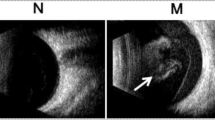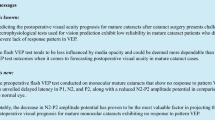Abstract
In 44 diabetic eyes with vitreous hemorrhage, monocular steady-state visual evoked potentials were elicited through closed eyes by a 10-Hz flash. Visual evoked potentials were rated as normal or abnormal on the basis of amplitude and waveform. Abnormal visual evoked potentials were subdivided into mildly abnormal, markedly abnormal and nonrecordable categories. Patients with normal potentials were predicted to have visual acuities of 6/15 (20/50) or better. Patients with abnormal potentials were predicted to have visual acuities of 6/18 (20/60) or worse. Final visual acuities were the best visual acuities recorded in the 6 months after vitreous surgery (vitrectomy) or spontaneous clearing of the vitreous hemorrhage. The visual evoked potential categories and final acuities were compared with a 2 × 2 contingency table. The accuracy was 86%. The visual evoked potential categories and final acuities were associated at a statistically significant level.
Similar content being viewed by others
References
Minkowski JS, Palese M, Guyton DL. Potential acuity meter using a minute aerial pinhole aperture. Ophthalmology 1983; 90: 1360–8.
Murphy GE. Limitations of blue field entoptoscopy in evaluating macular function. Ophthalmic Surg 1983; 14: 1033–6.
Faulkner W. Laser interferometric prediction of postoperative visual acuity in patients with cataracts. Am J Ophthalmol 1983; 95: 625–36.
Hirose T, Miyake Y, Hara A. Evaluation of severe ocular trauma: Electroretinogram and visual evoked response. In: Freeman HM, ed. Ocular trauma. New York: AppletonCentury-Crofts, 1979: 31–53.
Hutton WL, Fuller DG. Factors influencing final visual results in severely injured eyes. Am J Ophthalmol 1984; 97: 715–22.
Fuller DG, Hutton WL. Presurgical evaluation of eyes with opaque media. New York: Grune & Stratton, 1982.
Huber C, Knus M. Preoperative evaluation of traumatic eye lesions with visual evoked cortical potentials in response to sine wave modulated light. Doc Ophthalmol Proc Ser 1978; 15: 211–9.
Farber ME, Odom JV, Hobson R. Visual function assessment behind vitreal opacities: VEP assessment [Abstract]. Invest Ophthalmol Vis Sci 1985; 26(ARVO suppl): 32.
Scherfig E, Tinning S, Edmund J, Trojaborg W. Visual evoked potential as a prognostic factor for vitrectomy in diabetic eyes. Acta Ophthalmol 1983; 61: 778–87.
Scherfig E, Edmund J, Tinning S, Trojaborg W. Flash visual evoked potential as a prognostic factor for vitreous operations in diabetic eyes. Ophthalmology 1984; 91: 1475–9.
Fricker SJ. Analysis of the visual evoked response by synchronous detector techniques, I: Patients with cataracts. Invest Ophthalmol 1971; 10: 340–7.
Weinstein GW. Clinical aspects of the visually evoked potential. Trans Am Ophthalmol Soc 1977; 75: 627–73.
Weinstein GW. Clinical aspects of the visually evoked potential. Ophthalmic Surg 1978; 9: 56–65.
Foerster MH, Li XX. Evaluation of the central retina and optic nerve function in media opacities. Doc Ophthalmol 1986; 63: 101–6.
Odom JV, Hobson R, Coldren JT, Chao GM, Weinstein G. 10 Hz flash visual evoked potentials predict post-cataract extraction visual acuity. Doc Ophthalmol 1987; 66: 291–9.
Odom JV, Chao GM, Hobson R, Weinstein GW. Prediction of post cataract extraction visual acuity: 10 Hz visually evoked potentials. Ophthalmic Surg 1988; 19: 212–8.
Raju VK, Weinstein GW, Pillai K. Assessment of macular function in anterior segment surgery. Indian J Ophthalmol 1983; 31: 41–4.
Macsai M, Cavender S, Michael M, Odom JV. Prediction of visual outcome in pseudophakic bullous keratopathy: A comparison of the PAM and the VEP [Abstract]. Invest Ophthalmol Vis Sci 1991; 32(ARVO suppl): 1235.
Odom JV, Chao GM, Weinstein GW. Preoperative prediction of postoperative visual acuity in patients with cataracts. A quantitative review. Doc Ophthalmol 1988; 70: 5–17.
Fuller DG, Hutton WL. Prediction of postoperative vision in eyes with severe trauma. Retina 1990; 10: s20-s34.
Guyton DL. Misleading predictions of postoperative visual acuity. Arch Ophthalmol 1986; 104: 189–90.
Weinstein GW, Rylander HG. Photocoagulation of the fovea. Trans Am Ophthalmol Soc 1978; 86: 278–95.
Cavender S, Hobson R, Chao GM, Weinstein GW, Odom JV. Comparison of preoperative 10 Hz visual evoked potentials to post cataract extraction contrast sensitivity and visual acuity. Submitted to Doc Ophthalmol.
Odom JV, Weinstein GW, Farber ME, Chao GM. Test accuracy and predicting outcome. Arch Ophthalmol 1986; 104: 1584.
Fletcher RH, Fletcher SW, Wagner EH. Clinical epidemiology: The essentials. Baltimore: Williams & Wilkins, 1982.
Huber C. A clinical projection stimulator for sine-wave and pattern visual evoked response. Application to opacities of the ocular media and amblyopia. Doc Ophthalmol Proc Ser 1977; 11: 49–55.
Weinstein GW, Odom JV, Hobson RR. Visual acuity and cataract surgery. Ophthalmol Ann 1987; 3: 25–42.
Weinstein GW, Odom JV, Cavender S. Visual evoked potentials and electroretinography in neurologic evaluation. Neurol Clin 1991; 9: 225–42.
Leys MJJ, Candaele CMLJ, DeRouck AF, Odom JV. Detection of hidden visual loss in multiple sclerosis: A comparison of pattern-reversal visual evoked potentials and contrast sensitivity. Doc Ophthalmol 1991; 77(3): 255–64.
Author information
Authors and Affiliations
Rights and permissions
About this article
Cite this article
Vadrevu, V.L., Cavender, S. & Odom, J.V. Use of 10-Hz flash visual evoked potentials in prediction of final visual acuity in diabetic eyes with vitreous hemorrhage. Doc Ophthalmol 79, 371–382 (1992). https://doi.org/10.1007/BF00160950
Accepted:
Issue Date:
DOI: https://doi.org/10.1007/BF00160950




